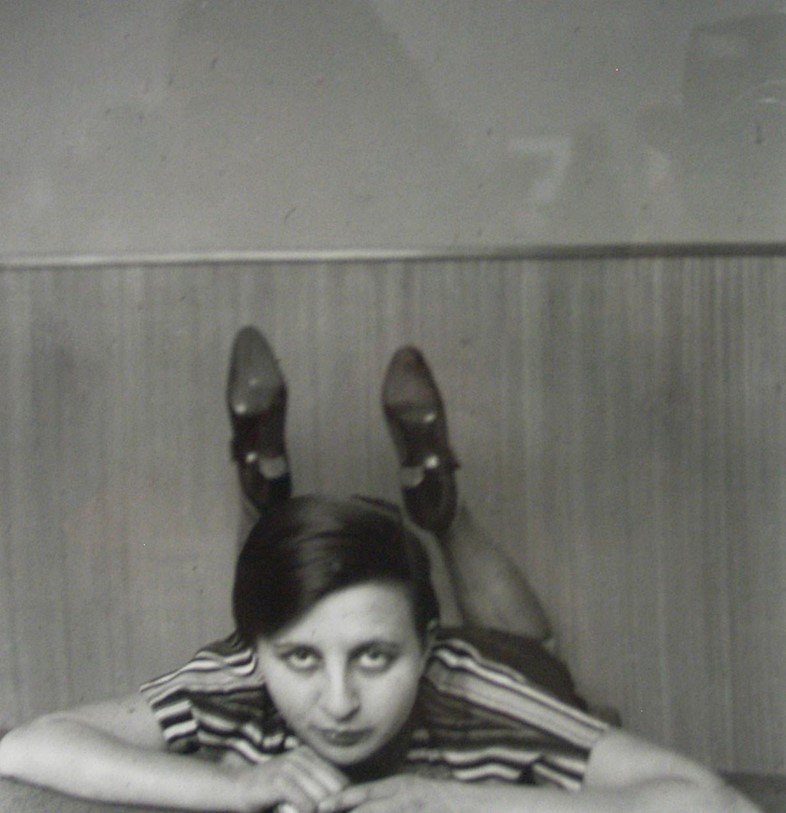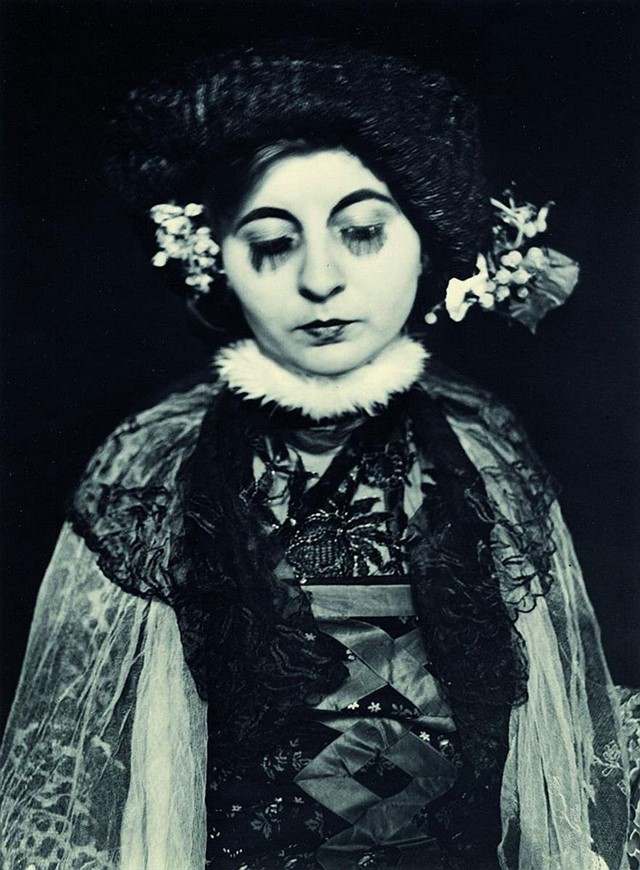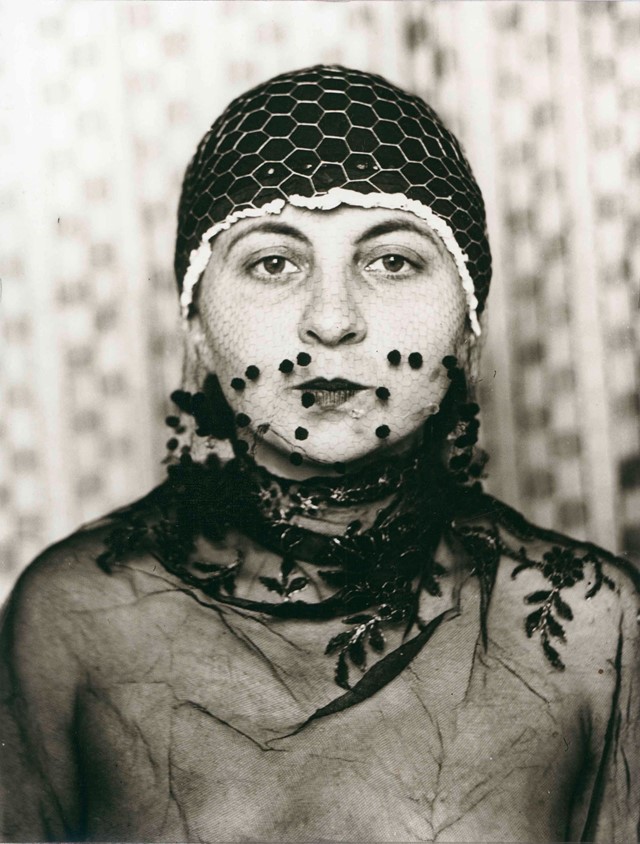Long before Cindy Sherman began experimenting with masks as a tool to disassemble womanhood, Gertrud Arndt was crafting a series of selves, Madeleine Morley explains
“I’ll never finish taking off all these masks,” wrote Claude Cahun in 1930. The performative self-portrait, and the filmic and photographic investigation into the “masquerade of femininity” which often accompanies it, is a theme that runs through artists’ oeuvres from that of Cahun and Maya Deren to Cindy Sherman. Indeed, while Cahun was writing poems and photographing herself wearing masks in Paris, former Bauhaus student Gertrud Arndt was also addressing the façade of femininity in Weimar Germany, where she staged portraits of herself under the series title Maskenselbstporträts – a term which translates to “masked-self-portraits”. Dressing in lace, veils, scarves and flowers – the lexicon of fetish – Arndt’s self-representations unmistakably invoked an excess of gendered identities, a series of disguises: the femme fatale, the good girl, the fun-loving flapper, the respectable lady, the serious and stoical widow, the new woman.
A few weeks ago, in the height of summer, I skipped work and took the train from my office in Berlin to the small nearby town of Dessau. It was a spur-of-the-moment decision; I wanted to visit the Bauhaus building that was designed by Walter Gropius in 1925 to house his vision of a utopian art university. Up on the second floor of the chequered school, wrapped in its iconic glass curtain, an exhibition space is currently presenting a show entitled Big Plans: Modern Figures, Visionaries, and Inventors. It features the work of modernism’s Bauhauslers – both its students and professors – until January 6, 2017, and it’s here that I saw six black and white photographs framed in a row like a strip from a Photobooth. Each self-portrait of Arndt showed the same woman, but pulling a different face.
Defining Features
Arndt mimics, mimes, performs and parodies the signs representing 'woman': like her contemporaries Cahun and Marta Astfalck-Vietz, these pictures articulate the early conceptualisation of the argument that there is no such thing as the woman, only her representations. In one photograph Ardnt puts her feet above her head playfully, like bunny ears; in another, she crosses her eyes quizzically; in the next, she peeks coyly from behind a veil in a slip that slips off her shoulder; in a fourth her eyes are shut and she wears flowers in her hair, like blue Ophelia. By deftly collecting the signifiers of femininity and erotic allure, these ‘masks’ make explicit reference to the myths of the new woman, and reference the ensuing entrapment or control of women.

Seminal Moments
When Arndt arrived at the school of art and design in 1923, at the age of 20, she had already spent three years working as an architect’s apprentice in Erfurt, and had her heart set on studying architecture. It was there that she began taking pictures of buildings in the town, capturing various speckled surfaces. There was no chance that she’d be allowed into the architecture class in Dessau however; instead, Arndt was inevitably steered into the weaving workshop, the supposedly more “feminine” subject that dealt with soft cloth, patterns and self-fashioning, not sharp steel, mighty structure and the lofty, all-encompassing “total art” of architecture. Men shaped the environment; women decorated it.
Once she had graduated and married fellow student Alfred Arndt, who she settled with in Dessau when he became a professor at the Bauhaus school, Arndt’s focus shifted to focus on her self-taught photography, drawing on techniques she’d learnt during her foundation year with the professor and photographer Lázlo Moholy-Nagy. Yet cloth would still feature heavily in her art, as she draped herself in veil and lace and stood against patterned fabrics for pictures. In some of these mask portraits, layers of fabric mesh into one another so that everything seems to be one and the same—background, clothes, shroud, and face all becoming one surface. Enveloping fabric becomes a second skin, suggesting the fabrication of self in a culture relentlessly obsessed with surface. It was a subversive move: she used the only medium she’d been allowed to study as a woman to reveal the restrictive fashioning of the feminine.
It was in 1933, living in Dessau, that Arndt took all 43 of her ‘mask’ self-portraits. While in some she plays with feminine archetypes of history and in the history of art (in one particular portrait, her hair cascades upwards and her breasts are exposed in the unmistakable guise of Klimt), other pictures present Arndt in the glamorous garb of the Weimar period’s modern “new woman”. She wears the cropped hair, flapper hat and provocative wide-eyed stare of Louise Brooks; some ‘masked’ selves look like silent movie stills, others are mostly flesh like the bodies of the Tiller girls. Arndt performed all the performing women of Weimar culture. In 1932, however, after the Bauhaus closed, the Arndt family moved to Probstzella in Eastern Germany. Three years after World War II they moved again to Darmstadt, and she more or less stopped taking photographs altogether.

She’s AnOther Woman Because…
The “masquerade of femininity”, the idea of the biological individual and the cultural person not being one and the same, has by now been widely explored in art. To look at Arndt’s work is to see that there were other histories beyond the myth of the Bauhaus, other experimenters looking at the theme of female masquerade before Sherman’s popular examples, others determining and thinking about gender as mask before Judith Butler gave this reality theoretical shape and weight.
It often takes a break in convention to find other narratives and persons of persona. For me, it took a break in the self I know best to go off dreaming and exploring Dessau one afternoon, in order to discover Arndt for myself.
Big Plans! Modern Figures, Visionaries, and Inventors runs until January 6, 2017 at the Bauhaus, Dessau.
